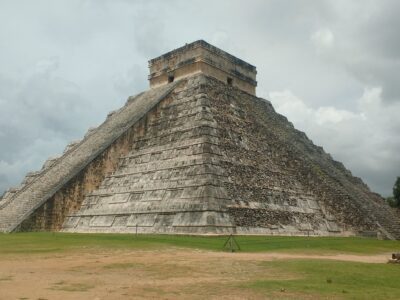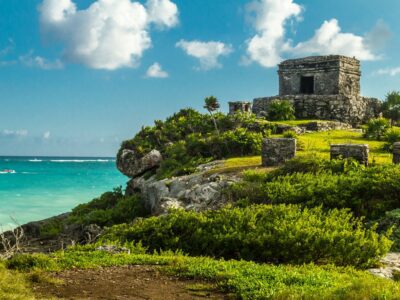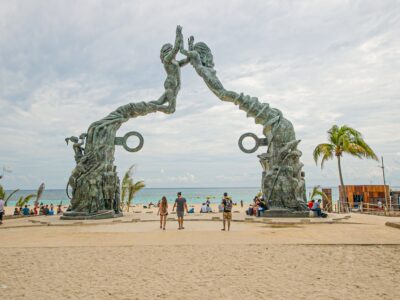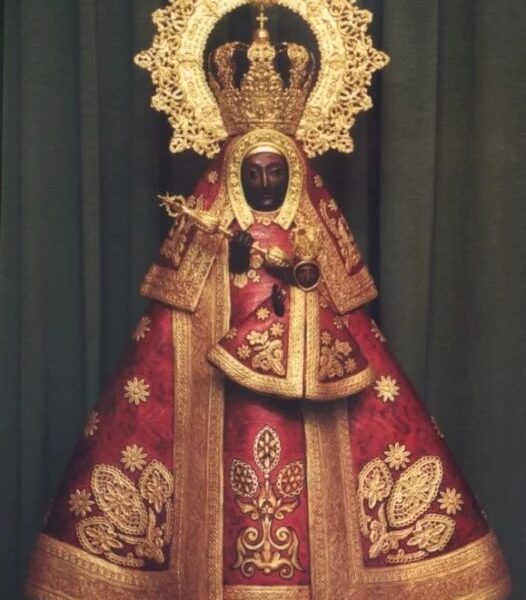We cannot understand Mexico without the Virgin of Guadalupe. Her image transcends a mere religious symbol. It is the greatest pillar of the cultural and spiritual identity of the nation.
Since her alleged apparition on Tepeyac Hill, she became a bridge between the pre-Hispanic world and European Christianity. The Virgin of Guadalupe has accompanied Mexico through its most crucial moments, serving as a banner in social movements, resistance, and hope. She is the mirror of a Mexico that finds its strength, faith, and essence in her… but is also a story full of enigmas, mysteries, and symbolism.

Santa María de Guadalupe – Cáceres, España.
The story of the Virgin of Guadalupe traces back to Spain, a time before Spain was a unified nation that consisted of various kingdoms conquered by different civilizations. Let us journey specifically to the region of Extremadura. In the 13th century, the veneration of an image known as “Our Lady of Guadalupe” emerged—a black virgin carved in cedar wood, which, according to legend, was “miraculously” discovered near the Guadalupe River. The river’s name is derived from the Arabic Wadi al-lub, whose meaning remains disputed—some say it means “river of black stones.” In contrast, others suggest it is a combination of the Arabic wuad (river) and Latin lupus (wolf), translating to “River of Wolves.” Regardless of the interpretation, this image cemented its religious importance in the southern part of what we now know as Spain.
“Our Lady of Guadalupe” was a central figure in medieval Spanish spirituality, seen as a protector during conflict, associated with military victory and Christian restoration. This symbol of faith traveled with the conquistadors to the Americas, who carried their swords and the images of their devotion. It is a significant symbol, especially for Hernán Cortés, a native of Extremadura and a fervent devotee of the Spanish Virgin of Guadalupe.
From Tonantzin to Guadalupe
To understand the profound connection between the Virgin of Guadalupe and pre-Hispanic traditions, it is essential to examine the role of Tonantzin, the mother goddess of the Mexica people. The place where, according to legend, the Virgin appeared to Juan Diego—Tepeyac Hill—was already a pre-Hispanic spiritual center dedicated to Tonantzin. This detail is not minor; cultural syncretism allowed the indigenous people to accept the Virgin of Guadalupe as a symbol that, while Christian, had roots resonating with their beliefs. This phenomenon marked the beginning of a devotion that, beyond religion, would become a key element of Mexican cultural identity.
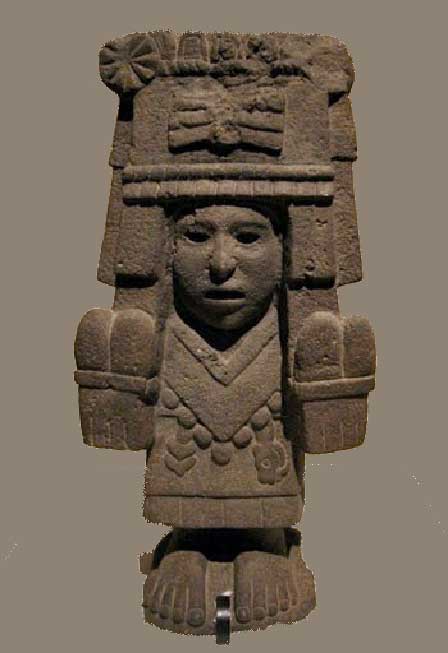
Tonantzin
Tonantzin, which means “Our Revered Mother” in Nahuatl, was depicted as a protective and generous deity fundamental to the Mexica worldview. Tepeyac was the most important pilgrimage site, where devotees brought offerings and performed ceremonies in her honor. After the conquest, Spanish missionaries initially sought to suppress these practices but eventually understood that directly imposing Christianity would not suffice. Here, cultural syncretism played an essential role. The transition from Tonantzin to Guadalupe allowed Indigenous people to become familiar with the new faith.
The Virgin retained elements of the benefactor mother while being framed within a Christian context that connected her to European Marian traditions. Fray Bernardino de Sahagún, in his chronicles, mentions how indigenous people continued referring to the Virgin as “Tonantzin,” reflecting the amalgamation of both traditions. This syncretism facilitated evangelization and gave the Virgin of Guadalupe a cultural significance that transcended religion.
This Tonantzin-Guadalupe connection, far from being a mere replacement, became a bridge that united Indigenous peoples and conquerors in a shared—though often unequal—narrative that gave rise to mestizo identity. Her spiritual and cultural influence became a testament to how beliefs and traditions can transform and survive through the centuries.
An Emblem of the Conquest or Genuine Faith?
The Guadalupe-Tonantzin syncretism was crucial in consolidating Spanish dominance in the New World. For the colonizers, evangelization was as important as territorial conquest, and the Virgin became a bridge between both worlds. She represented the “Mother of God” for Christians and embodied familiar elements for the indigenous population, such as her appearance on Tepeyac, a sacred place.
Some historians have hypothesized that the Church and the colonial government strategically used the Virgin to legitimize the conquest. The Guadalupan narrative allowed Christianity to integrate into indigenous communities, presenting itself as a religion that respected and adopted local elements. This created an emotional and spiritual connection that eased the acceptance of colonial values. This duality between her political use and her spiritual power remains a subject of debate.
From the Celestial to the Human – The Enigma of Marcos de Aquino
Marcos Cipac de Aquino remains an enigmatic figure. Historical records identify him as a highly skilled Indigenous painter of the 16th century who allegedly created the original image of the Virgin of Guadalupe in the New World. Cipac de Aquino was a renowned artist known for combining European techniques with Indigenous styles, making him one of the leading exponents of New Spanish art.
In 1556, Friar Francisco de Bustamante delivered a sermon claiming that the Virgin’s image was painted by “Marcos, the Indian.” However, after this mention, Marcos virtually disappeared from historical records. Why was an artist of such talent and relevance almost erased from history? Some researchers suggest that his authorship was intentionally downplayed to strengthen the Guadalupan miracle narrative. If the image were the product of human hands, it would lose its supernatural character, weakening its impact on evangelization.
Marcos de Aquino’s legacy remains in the shadows, but his contributions to New Spanish art and religion continue to be studied. If he indeed painted the Virgin, his work transcended the artistic realm to become a symbol of faith and unity.
Faith and Reason: Miracle or Fabrication?
Juan Diego’s tilma, where tradition claims the Virgin’s image was imprinted, has been the subject of countless scientific investigations. Some studies have pointed to the absence of brushstrokes and the inexplicable preservation of the ayate—a fabric made of plant fibers that should have disintegrated centuries ago. However, other analyses suggest that the image displays characteristics of 16th-century painting, fueling the debate between faith and reason.

Researcher Dr. Philip Serna Callahan used infrared technology in the 1970s to analyze the tilma. His study revealed that the image needs more preliminary outlines, something extremely complex to achieve with conventional painting techniques. Other studies have highlighted the colors’ complexity and the absence of a scientific explanation for certain significant details, such as the supposed reflection of human figures in the Virgin’s eyes. On the other hand, the miracles attributed to the Virgin, from curing diseases to intervening in historical conflicts, have been questioned. While these stories are central to popular devotion, the lack of verifiable evidence fuels skepticism.
The Virgin’s Significance in Mexican Psyche
The Virgin of Guadalupe is not just a religious symbol; she is a national emblem that has accompanied Mexico through its most critical moments. From the War of Independence, when Miguel Hidalgo carried a banner bearing her image, to the Mexican Revolution, the Virgin symbolizes resistance and unity.
Today, her influence transcends religion. She is a cultural icon representing mestizo identity, hope in difficult times, and the spiritual connection of millions of Mexicans. Her presence in altars, murals, and social movements reflects her role as a protective mother and symbol of belonging.
In 2024, the Virgin of Guadalupe remains a bridge between the human and the divine, the past and the present, faith and reason. Her story, filled with enigmas and symbolism, continues to mirror Mexican identity, uniting a people in its diversity—particularly in its profound contradictions.
For Times Media Mexico / The Yucatán Times
In collaboration with Notired
José E. Urioste Palomeque
December 12, 2024
Mérida, Yucatán.
—
 José E. Urioste is a Yucatecan businessman and a seasoned Business Intelligence professional. In addition to his business acumen, Mr. Urioste writes for multiple media outlets nationwide. His writings are engaging and critical, and he is unafraid to tackle controversial topics and challenge prevailing norms with a clear and often unyielding perspective. He has significantly contributed to the media landscape, sharing his insights through articles and hosting radio shows that provide in-depth social, business, or political analysis.
José E. Urioste is a Yucatecan businessman and a seasoned Business Intelligence professional. In addition to his business acumen, Mr. Urioste writes for multiple media outlets nationwide. His writings are engaging and critical, and he is unafraid to tackle controversial topics and challenge prevailing norms with a clear and often unyielding perspective. He has significantly contributed to the media landscape, sharing his insights through articles and hosting radio shows that provide in-depth social, business, or political analysis.
The post The Guadalupan Enigma: Between Faith and Reason first appeared on The Yucatan Times.








